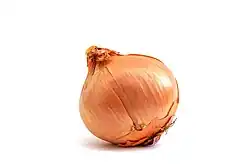Pyruvate scale
The pyruvate scale measures pungency in onions and garlic with units of μmol/gfw (micromoles per gram fresh weight).[1] It is named after pyruvic acid, the alpha-keto acid co-product created in the biochemical pathway that forms syn-propanethial-S-oxide, the main lachrymatory agent in onions.
Examples

The standard onion has an eight rating, while "sweet onions" have a two or three rating on the scale. The lower the score or scale the more "sweet" the onions are rated. Anything less than five is considered a sweet onion. The Vidalia onion variety is considered sweet and must have a score of 5.0 μmol/gfw or less. The HoneySweet brand onion is claimed to consistently rate with a pungency level of 3.5 or less.[2]
The Supasweet onion (usually grown in Lincolnshire, England) registers 1.5 to 2 on the scale.
Influential factors
Soil type, rain, and sunlight affect the pungency in onions and garlic and, therefore, their score on the pyruvate scale.
See also
- Scoville scale – Scale for measuring spiciness of peppers
References
- ^ "Spring 2001 Commercial Vegetable Variety Trials" (PDF). Retrieved 2011-06-21.
- ^ "HoneySweet key to J&D onion program success". March 14, 2018. Retrieved 26 May 2024.
External links
- The National Organic Program — by the USDA